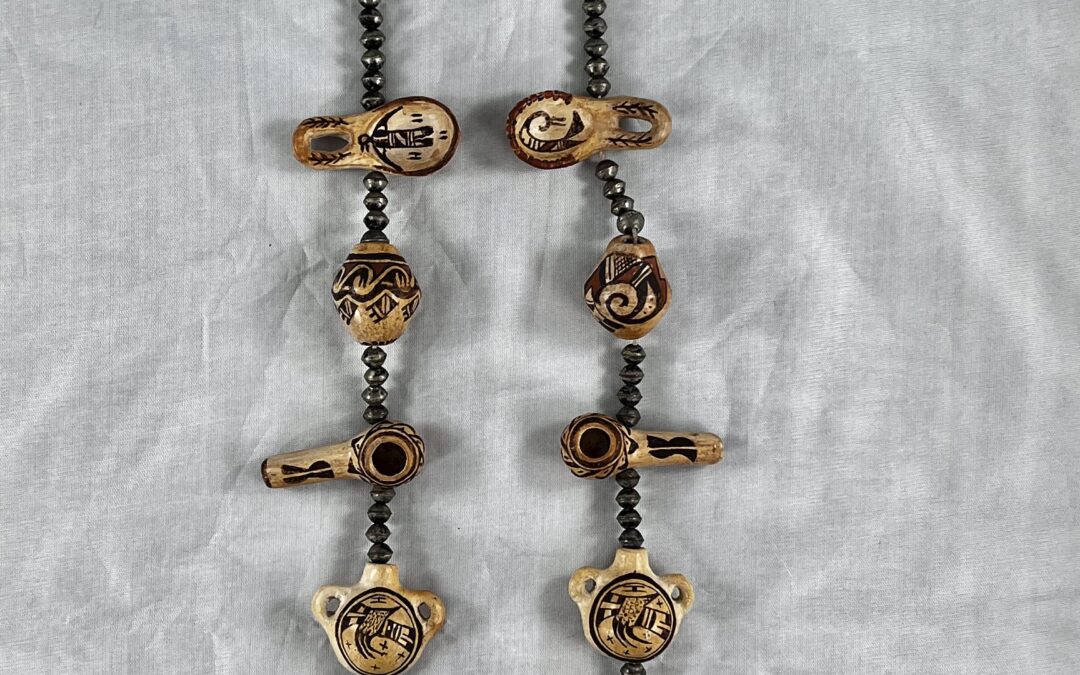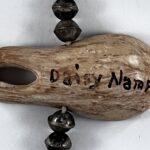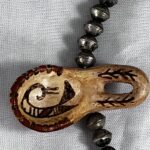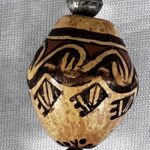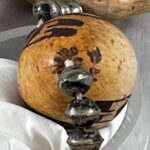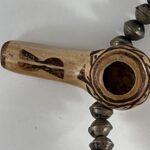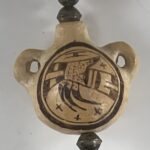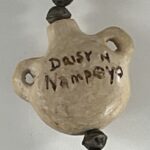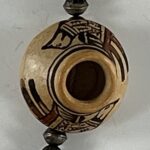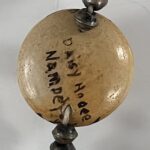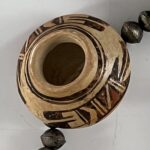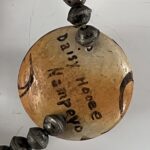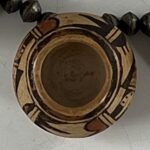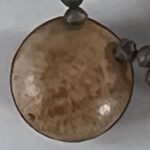- The necklace has an overall length of 32 inches.
- The two ladles & two pipes average 0.532 “ h X 0.855” w X 2.0” long.
- The four jars average 0.969″ h X 1.00” w.
- The two canteens average 1.25” h X 1.50” w X 0.875” deep.
- The pendant is 0.75” h X 1.50” w.
- The 80 beads are silver and are handmade.
This is an unusual —probably unique— necklace, the only necklace from Hopi I have ever seen incorporating miniature pottery. The potter, Daisy Hooee Nampeyo, was the granddaughter of Nampeyo and was an exceptionally-talented artist, a skill fully tested by the detailed forms and decoration of the 11 miniature pots in this necklace. The provenance of the necklace is known in detail. The necklace is also beautiful, cute, and fun.
Organizing a discussion of 11 pots simultaneously is a daunting task. Detail might easily overwhelm clarity. The ten pots along the sides of the necklace are paired by shape, though their decoration is not always similar. The bottom pendant is larger and unique. Accordingly, the discussion will be organized by pair, with the left pot carrying the appellation “a” and the right pot labeled “b.” Pots in a pair will be discussed together.
Form and design:
The 11 pots discussed here seem too small to have been built off a puki base and so I assume they are pinch pots.
Pair 1 : Ladles
Ladle 1a has a shallow scoop and a loop handle. The handle is somewhat darker than the scoop due to its outdoor firing. The lip of the scoop, except for the circumference that becomes the handle, is painted red. An avian image fills the bowl and flows up through the gap in the red lip, its head resting on the small flat space between the bowl and the handle. A short neck supports a circular head, two lines form a gaping mouth. The wings are thin, pointed, black and sickle-shaped, with small unpainted patches at their base. The arc of wings sits above a linear body. A gap between two black pectorals marks the chest. Below are two parallel lines, a one-lane “highway,” followed by a black square bisected by an unpainted diagonal. Below are three parallel lines (a two-lane highway). Two tails with unpainted bases and rounded black tips complete the body of this proud bird. Above the bird, on either side of the handle, are corn plants with 7 to 8 projecting leaves. Signed clearly “Daisy Nampeyo.”
Ladle 1b has the same shape as ladle 1a. When purchased the handle was missing. Andy Goldschmidt of Ceramicare duplicated the handle using ladle 1a as a model. The underside of the scoop is golden from the outdoor firing. Like ladle 1a, this ladle features a red lip around two-thirds of the circumference of the scoop, but this rendition has a fancier layout. What the eye sees as an essentially red rim is actually composed of 11 red dots flanked by 12 black dots. Interior to the scoop is a typical abstract bird. Its body is curved, though with a sharp edge as the body meets the neck. The curved black head carries a two-line crest. The neck is unpainted; the body displays a diagonal red stripe embedded at the center of a string of 6 vertical black lines. The tail is composed of two black triangles, one in line with the body and one rising at a right angle to the body. Andy has decorated the handle of ladle 1b with the corn design found on ladle 1a. We do not know the original design of the handle of ladle 1b. This ladle is unsigned.
Pair 2: Tall pots
Pot 2a: The surface of this pot is pale without blushing from the outdoor firing. It carries a version of the Nampeyo family migration design. Thick-above-thin framing lines encircle the neck. Pendant from the neck is a band of red design, its lower edge 7 pointed curves. Below is a chain of seven black two-pronged wings, each wing nestled in a red curve above. Below each wing is a square black element incorporating two unpainted diagonal stripes with a third stripe forming the lower edge of the square. A three-pronged comb, presumably representing feathers, terminates this design element. Encircling the hole at the bottom of the jar is the signature “Daisy Nampeyo.”
Pot 2b: Because of its outdoor firing, one side of this pot is substantially more golden than the other. The pot carries a circular avian design, repeated twice. The design is intricate, especially given its small size. A broad black head with a white unpainted form at its center displays a long, curving proboscis. A red crest with two points crowns the head. After three parallel lines (a “two-lane highway”) a red wedge marks the shoulder of the bird, followed by an unpainted equilateral triangle cross hatched by 4 X 6 lines. A stylized backward-facing black U follows. At its center is a red pointed wedge, followed by a small unpainted triangle with a single-lane highway at its base. Completing the bird is a tail ensemble: a small black triangle points to the rear followed by an unpainted two-point comb. Each point has a black tip with a curved end, representing tail feathers. Encircling the bottom hole is the signature “Daisy H Nampeyo.”
Pair 3: Pipes
Pipes 3a and 3b: These two pipes have a light surface without blushing from the dung fire. The stems of the pipes have small linear holes from mouthpiece to bowl.They carry the same design. Thick-above-thin framing lines encircle the bowl. Pendant from the bottom line are 9 check marks. Floating above the crook of each check is a black dot. The stem of the bowl is marked with two parallel forms separated by a thin unpainted line. The elements display two humps, one triangular and one rounded. These parallel forms are oriented in opposite direction. Pipe 3a is signed DHN. Pipe 3b is signed “D H Nampeyo.”
Pair 4: Canteens
Canteens 4a and 4b: Canteen 4a shows slight golden blushing around one handle, otherwise the surfaces of the canteens are pale and without blushing. With two tiny exceptions the decoration of these canteens are the same, so they will be described together. The domes of these canteens are encircled by thin-over-thick framing lines. The central design is a display of feathers, but lacks a head, so I do not think of it as a bird.
At the core of the design is a stippled form roughly in the form of a vertical rectangle resting on its short side. The upper right-hand corner is elongated into a point. From the left side of the rectangle emerge two feathers composes of black bases, unpainted midsections and square black tips. From the bottom of the rectangle hang three sickle-shaped black feathers.Two small lines from their base intrude into the stippled area above, as if they were bolts used for attachment. The right edge of the stippled core displays two relatively large feathers. The have a black strip as a base, followed by an unpainted two-lane “highway,” followed by another black strip. An unpainted “comb” follows, its two points caped by square black tips.
Distributed in the unpainted space below this feather pattern are 4 small “x” elements. A fifth “x” is painted in the upper right quadrant of the right but not the left canteen. Directly above the central design on both canteens is an element in the form of a “H” laid on its side. The cross-piece of the left rendition is a simple line; on the right canteen it has the form of a small black square. Both canteens are signed “Daisy H. Nampeyo.”
Pair 5: Low pots
Pot 5a: The rim of this pot has a slight golden blushing. The design has thick above framing lines just below its short neck. Two 1.5-inch long birds encircle this pot, their design complex and almost identical. The bird that is lower when the necklace is worn is more carefully painted than its upper companion.
Realistically-shaped unpainted heads feature a short black beak and a small circle for an eye. The base of the head is marked by a black band with a forward-facing point at its center. Three parallel lines (a “two-lane highway”) follow.
The core of the body is roughly rectangular, though its right edge turns upward into the neck. Fit into this space are two small stippled forms with somewhat the same shape as the central stippled form on the canteens. Here these stippled elements have the shape of two rectangles lying on their long side, their upper-right-hand corner elongated into a point. One rendition is piled on another. The residual space in core of the bird forms two unpainted triangles pointing to the rear. Set into these spaces are simple lines with three cross marks. Above this central section of the body is a familiar black wing element: a curved front edge, followed by an unpainted stripe, and terminating with three pointed feathers emerging from a common base. This same wing is an integral part of the “migration design” developed by the Nampeyo family (cf 2023-01).
Finally, behind the core of the body is a vertical red stripe with pointed ends to the rear. From its left edge emerge two tail feathers with red bases and black tips. The canteen is signed “Daisy Hooee Nampeyo.”
Pot 5b: This small jar is strikingly golden-blushed on much of its lower surface. Like canteens 4a and 4b above, the designs on this pot are displays of feathers but lack a heads, so I do not think of them as a birds. Pot 5b carries thick-over-thin framing lines and two identical designs. Each rendition is 2.0-inches long.
At the center of the design is a red square bisected by a diagonal unpainted strip. Bordering both left and right edges of the square are unpainted “two-lane highways.” Sprouting from the center of the right highway are two elongated fan-shaped feathers. Flanking these feathers are two right triangles.
To the left of the central red element is a black square, its interior largely filled by a right-pointing, unpainted, “V” shape. Foreground/background reversal also allows us to see this square as an unpainted space intruded into by two triangles on the right and a larger isosceles triangle to the left. The left edge of this design is bordered by a one-lane highway. The highway serves as the base of a white comb base; its two extensions are feathers caped by rounded black tips. The pot is signed “Daisy Hooee Nampeyo.”
Pendant pot:
The pot is somewhat saucer-shaped. The rounded bottom curves up to the waist of the jar; from the waist to the lip the surface is sloped but flat. There is slight blushing from the outdoor firing, especially around the lip. The rounded bottom shows clear striations from being polished with a smooth stone.
Thick-above-thin framing lines encircle the rim of this small pot. A single thin framing line encircles the waist. All of the painting is on the upper surface of the pot between these framing lines in a band 0.375-inches wide and about 4-inches long. The pot carries a design that is repeated twice.
The band of design is continuous. We start our discussion at a black hill set on its edge. One rendition of this hill sprouts two parallel lines at its apex (“whiskers”), the other example lacks this adornment. At the base of the hill are three parallel lines, a two-lane highway. Based on the far side of this highway is an element shaped like a large W: a tall isosceles triangle is flanked by two right triangles. They point across an unpainted section to an asymmetric red form consisting of a hill drawn next to an isosceles triangle, both pointing back at that black W. At the base of the red element is another two-lane highway.
On its far side is an element taking the form of a U-shaped magnet, it black tips affixed to the highway, its unpainted arc end displaying 5 small black dots. A small pointed element fits over the curve of the arc to square it off so it rests firmly against a one-lane highway. On the far side of this highway is another isosceles triangle. A sliver of its upper surface is a thin, black triangle; its larger lower space is a stippled triangle. The point of this triangle touches the lower edge of the black hill with which we began this discussion. The bottom of the pendent seems to be signed “Daisy Hooee Nampeyo,” but this lettering is indistinct, being both greatly faded and somewhat lost in the polishing striations.
Beads and cord: The 5 spaces between the pendant and the top pot each contain 4 silver beads: 20 beads on each side of the necklace. Between the top pot and the tie-off there are 20 beads on each side of the necklace. Thus, in total, there are 80 silver beads incorporated into the necklace. Notice also that the string used to make the necklace is rather thin, ordinary, cord.
Design Analysis:
If this necklace was frequently worn, the edges of the pottery would soon wear through the cord. Thus I believe that this necklace was intended for display and not wearing.
As we have seen, the eleven pots are organized into five pairs plus the somewhat larger pot in the lower central position. Any order of pots was possible, but consider the visual impact of the necklace had the pots been presented in a random order. In that case all areas of the necklace would have the same visual appeal, like a typical Zuni fetish necklace. Instead, the pairs of pots on this necklace create a regularity of pattern. The lowest pair flank the pendant of the same form, thus creating focus. Pattern plus focus increases the visual attractiveness of the necklace.
Miniature pots from Hopi are known but uncommon. They have been made by some of the great names: Nampeyo of Hano (2002-12) and Dextra Quotskuyva (2011-31).The 11 pots on this necklace are more sophisticated than either the Nampeyo or the Dextra miniature pots. The largest of the 11 pots discussed here (the pendant) is smaller than the Nampeyo miniature pot and just about the same width as the Dextra miniature. The shapes of these necklace miniatures, however, are much more complex than either the Nampeyo or Dextra miniatures and the designs on the necklace pots are dramatically more complex and carefully-drawn than those on either the Nampeyo or Dextra pots.
How is it possible to close-off the vertical vases (pair 2), the low jars (pair 5) or the pendant? How does an artist take a small ball of clay and form tiny pipe bowls with attached hollow stems (pair 3)? Most extraordinary are the two canteens (pair 4). Forming a large canteen with a domed front, flat back, narrow spout and thin neck is challenging. Creating these canteen dimensions in the tiny form of pair 4 seems impossible to me, except that Dasiy has managed the task. Even the largest of the necklace pots —the pendant— is not straight-sided but rather has a carefully-shaped rounded lower bowl that supports a sloped upper surface.
The quality of painting on the pots in this necklace is extraordinary, though the complexity of design varies. Pipes 3a and 3b carry relatively simple designs. The other 9 pots carry complex designs one would expect to see on far larger pots. The design inside the scoop of ladle 1b is a bit awkward, the most awkward painting among the eleven pots. Far more complicated designs on the remaining 8 pots are exactingly drawn to the highest standards.
While this collection contains 10 pots by Daisy other than those in this necklace, I admit to a fondness for 2019-16, which is by far the largest Daisy pot in the collection. I find the design on this jar, combined with the pot’s unusually large size to be particularly impactful. It is a shock, therefore, to see that the design on canteens 4a and 4b have the same visual impact as the design on pot 2019-16. This comparison thus becomes an unexpected test of the ability of Daisy Hooee Nampeyo. Does the size of a pot affect the quality of Daisy’s painting? Apparently not, a feat of skill that I find unnerving. Expand the pot photos above and make your own judgement about the quality of painting.
Daisy’s painting is so exact that I believe I have found a secret code on the lip of scoop 1b. Notice this rim is composed of 11 red “beads” interspersed among 12 black beads. I believe this to be an abstract rendition of the necklace of which ladle 1b is a part: 11 miniature pots interspersed among 12 lengths of (now tarnished) silver beads. Such a theory might be fantasy, but I find it highly satisfying.
The red lips on ladles 1a and 1b are a holdover from the earlier Polacca tradition. Low pot 5b exhibits foreground/background reversal, enlivening the design.
Appendix E tries to define a schema whereby we might determine whether Fannie or another relative painted and signed Nampeyo’s pots after she became bind. Fannie consistently capitalized the “E” in Nampeyo. Most other relatives employed a lower-case “e.” Daisy generally used a lower case “e” but sometimes used an upper case “E” on miniatures (cf 1994-08 and 2007-02). The additional signatures on the 11 necklace pots add a good deal of data to the signature schema. The pattern of necklace signatures is mixed and (oddly) does not change the distribution of the lower and upper case e/E we find on other signed Daisy jars in the collection.
- Two necklace pots are either unsigned or signed with just initials (1b and 3a).
- Five pots are clearly signed using a lower case “e” in “Nampeyo.”
- Two pots are likely signed using the upper case “E” in “NampEyo,” though the form of this letter is not entirely clear (4a, 4b).
- Two final necklace pots carry such an unclear signature that a determination cannot be made (2b and the pendant).
Overall in this collection, including this necklace, 71% of signed pottery by Daisy display a small “e” in the “Nampeyo” signature; 29% display a capital “E.”
The visual impact of this necklace, both the overall view and the detailed observation of each pot, is stunning. Great art is like that. It picks you up and puts you down in an unexpected place. Daisy Hooee Nampeyo was perhaps the greatest artist of her generation of the Nampeyo family, a status fully supported by the spectacular tiny pots of this necklace.
About Daisy Hooee Nampeyo and this necklace:
Daisy had an extraordinary and cosmopolitan life. She grew up at Hopi, as a teenager moved to Los Angeles with a very wealthy Anglo family who arranged treatment to cure a disease of her eyes, was enrolled by them in L’Ecole des Beaux-Arts (Paris), saw Lindbergh land in 1927, returned to Hopi where she helped Grandmother Nampeyo make pottery, was married, had children, was divorced and moved to Zuni where she lived the rest of her life. There she was married a second time, became a widow, and married a third time. While at Zuni she continued to make both Hopi and Zuni pottery, sometimes encorporating both styles in a single pot (2011-13). For more detail about her life, see the catalog entry for pot 2011-13.
I sent a photograph of necklace 2022-12 to Ed Wade and he responded by email on 9-27-22:
“I have never seen anything like it. Must have had a great story associated with it.”
That story is known and gives insight into both the history of the necklace and the life of its maker. To preserve this history, the story will be presented here in detail.
The Kennedy family of “Indian Traders”:
Much of this information is from John D. Kennedy, who sold the necklace to me. We exchanged emails on September 15, 16 and 26, 2022 and spoke by phone on October 8, 2022. For clarity I have rearranged some of the information he provided. Information was also gathered from published sources, as indicated.
John D. is a member of the youngest of three generations of “Indian Traders” in his family.
The oldest generation: His grandfather George E. Kennedy “was one of the early Indian traders on the [Navajo] reservation, opening a trading post in Salina Springs within the Tselani Chapter in 1912…(The Gallup Independent (NM) 11-1-14).
The middle generation: “[George’s three sons] were raised as trading post kids, learning Navajo and being either home-schooled or taught by a live-in teacher. [One son, John W. Kennedy] was born in 1912…and married Georgiana Monaco in 1940. [They] raised eight children…and were married 74 years….[John W.] opened his own Indian arts and crafts store, Gallup Indian Trading Company [and] by the 1960’s [he] had become the biggest wholesaler of Indian crafts in America (The Gallup Independent (NM) 11-1-14).” “The 50s through the 80s was the apex of Navajo reservation trading. The demise began in the late 80s…[The Kennedy] family participated in the evolution of the business from horseback and wagons to airplanes and computers. (John D. Kennedy says of his father): My dad (John W.) was a wealth of information on trading and we bantered about it for years. He was one of the smartest people I have known. He retired from trading at the age of 98 and then passed away in his 102nd year in 2015. I and my family had a great run with him (kennedytraders.com).”
The youngest generation: The seller of the Daisy necklace, John D. Kennedy, grew up in his family’s Indian trading business and returned to it shortly after graduating from college. “In 1982 I split from our family business and started my own company. I went from working with nearly one hundred employees to one… I focused my business on large companies in the western national parks as well [as] Disney world-wide. For most of my accounts I was their exclusive supplier of American Indian arts and crafts. My experience provided opportunity to handle special quality arts and crafts. Arguably, I dealt with more North American tribes and Eskimos that anyone in the business (kennedytraders.com).”
Daisy Hooee Nampeyo and the Kennedy family:
“She lived her adult life in Zuni, where I (John D Kennedy) met her as a child. She was married to a Zuni, Leo Poblano, who taught her to make Zuni inlay jewelry. They made jewelry together. Leo worked with my dad at his Zuni trading post in the early 40s. Daisy worked with my mom to help with us kids at home. Leo was killed while fighting a forest fire in California in 1945 and Daisy became a widow. When Dad sold his interest in CG Wallace Trading in 1946, we moved to Gallup. Daisy came to Gallup with us and lived with us for two years. Dad was bedridden for a year from back surgery….Daisy was a vivacious and happy woman who was always singing Hopi and Zuni songs… Daisy was a very pretty woman. She was very kind and gentle and a great person to have living in our home.

Georgiana and Daisy
She remained a close family friend until her death in the late 90s.”
The Necklace:
(John D. Kennedy speaking):
“The idea for the necklace was Daisy’s. She made the pots, but we (John W. and Georgiana Kennedy) gave her the beads. The beads are handmade, sterling silver, made in the 50s. Few necklaces have beads made by the necklace maker, especially Zuni. The majority of beads are made by Navajos NW of Gallup in the Mariano / Pinedale area. We always bought necklaces and beads separately and then had them strung. Until the 60s, beads were shaped on a tree stump. Silver was cut into squares, a hole punched, the bead was shaped and then the halves were soldered together. Once done, the beads are strung on wire for buffing and polishing. In the 60s metal block dyes became available and eliminated the tree stumps. These (the beads in this necklace) were made the old way.
The necklace is very old and I don’t remember how or when the (upper right-hand ladle handle) broke. As I recall Daisy made the pots and assembled the necklace in the 60s and it hung on my parent’s (John W. and Georgiana Kennedy’s) wall for 30 years and my wall for about as long. I don’t believe the necklace was ever worn.”

